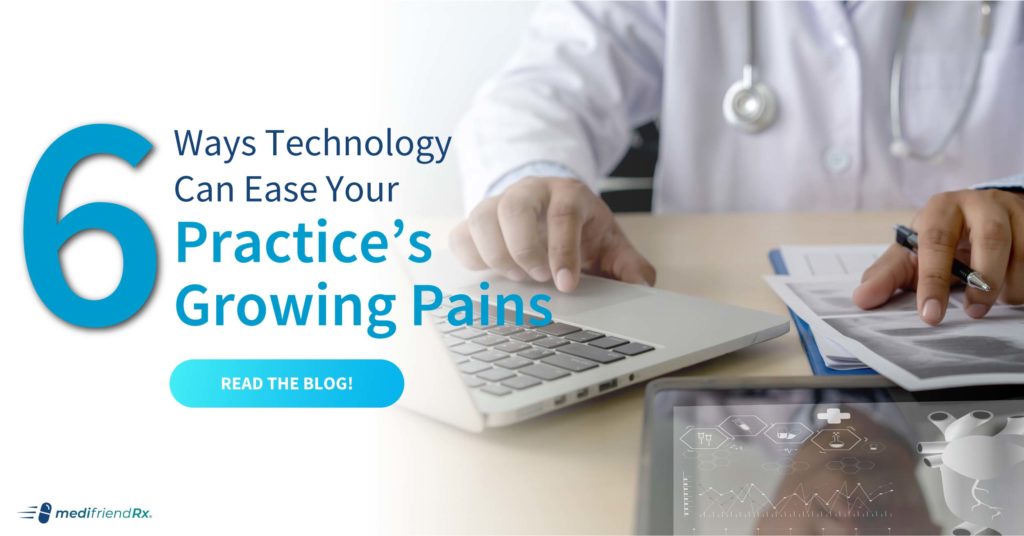Even if your practice is booming right now, sustaining that success in the future means you’re continually looking for ways to grow to better meet your patients’ needs.
But growth doesn’t just mean serving more people in the same way – in many cases, it requires major operational and even cultural shifts.
If you and your staff are spending the majority of your time putting out fires, it can feel impossible to step back from daily tasks long enough to gain the flexibility needed to grow your medical practice.
Without a solid growth plan, the steps you take today may backfire in the future. Adding extra staff, software, or space too soon or without enough planning can quickly eat up any added profit.
Recognizing and overcoming the common obstacles associated with growth are essential if your practice is to continue to grow: once you know what your obstacles are, technology (at least when it quickly fits into your existing workflows and can grow with you) can reduce or eliminate many of the pains and pitfalls associated with a growing practice.
In other words, growing pains aren’t inevitable – having the right tools, information, and systems make scaling up much easier.
Here are some of the top growing pains facing localized practices, and the top technologies to simplify or eliminate those pains:
The 6 Most Common Practice Growing Pains – And How Technology Can Avoid Them
Information Access
The problem:
Lack of insight into your competitive landscape and the growth barriers specific to your organization makes good decision-making impossible.
You cannot sustainably grow without a clear idea of your current stats, including revenue, profits, patient volume, and market share.
Getting fine-tuned data, such as information on your practice’s percentage of new vs. returning patients, the ratio of claims passed on the first try, and how the staff is spending their time in and out of appointments, is critical to establish trends and success metrics over time.

How tech can help:
There’s no shortage of information in healthcare — data are everywhere. The trick is to make sure you can use and communicate it effectively.
- Information technology and health informatics tech are crucial elements of your team’s ability to communicate and access information – for example, finding the right records when you need them, and storing them securely.
- Technology can also provide information-gathering tools, such as digitized patient surveys, to give you your own view of what’s happening for your patients, without needing to rely on reacting to CMS or other external evaluations after the fact.
Practice Reputation & Reach
The problem:
It’s increasingly difficult to stay visible to prospective patients. Doctors across the country are seeing less traffic, and uncertain regulations and increasing competition also make it harder to find new patients.
Many practices still rely on referrals, but referrals aren’t enough – to expand sustainably, you’ll need to show up in the places people are looking for care and stay visible there.
How tech can help:
Technology has already changed how patients access information about your practice.
The majority of people choose doctors based on the reviews they see about them online. Most say online profiles change their opinions about a physician, and millennials use online reviews as their main criterion for choosing a physician.
Think with Google found that 77 percent of patients use online searches for finding a physician, and this was all the way back in 2012 – the number of people using digital tools has skyrocketed since then. Almost half of the people searching for a doctor on mobile devices end up booking an appointment.

Think with Google also revealed that practice reputation is the number 1 most important factor when selecting a new physician, with 94% people highlighting this as a key factor.
Technology is key to making sure you show up in front of these people in the right way.
It is getting harder to compete with the public hospital down the street with a multi-million-dollar marketing budget. But marketing and advertising tech help target patients highly specific to your area, practice, market, patients, making your spend strategically successful and keeping you competitive.
Tools such as social media also offer a number of advantages. Increasing your presence has a very low barrier to entry, and the majority of people in the U.S. are on social media – these efforts can easily be scaled with you.
In short, given the technological resources available, you should have the systems and technology in place to make sure patients looking for care can immediately be made aware of who you are and what makes you better than your competitors.
Medicare Star Ratings
The problem:
Lagging behind on your star rating can cost you thousands in potential revenue and lost rebate percentages.
The CMS’ hospital star ratings also provide an important metric for patient satisfaction and the quality of the care you provide.
They are designed to make it easier for patients to choose providers. Already, as many as 1 in 5 patients use this information to choose a provider.
They also directly take into account assessments of patient satisfaction data, making them a largely accurate reflection of the experience patients have in your organization. Making sure you have the best possible star rating:
- Improves practice reputation.
- Converts more prospects into patients.
- Makes you eligible for higher rebate percentages.
- Improves overall profitability.

How tech helps:
Available technology offers ways of getting visibility of your current star ratings to drive more effective improvement efforts.
It can also:
- Support better care.
- Automate claims processing and customer service.
- Improve patient experience through better online engagement.
- Simplify medication access through online prescribing or point-of-care pharma.
For an in-depth guide to boosting your Medicare Star Ratings, check out our ebook: The Ultimate Guide to Boosting Medicare Star Ratings in 2019 (and beyond).
Patient Experience
The problem:
Patient retention is a major issue. Patients have more choice than ever before, which means that you’ll have to work harder to keep winning people over – even after they’ve already come to your practice.
Every stage of a patient’s experience with your care – from when they first hear your name all the way through referring their friends to visit your practice – should be part of your marketing and growth strategies.
Improving the patient experience is what will allow you to add more value than anyone else, creating fans who will refer others and end up happier and healthier.

How tech can help:
Patients are overwhelmingly interested in using technology for their health care.
For example, in one survey, 85 percent said that seeing the latest technology at their care provider made them feel more comfortable about the quality of care offered.
As of 2018, 70% prefer digitized healthcare and more decision-making power when it comes to seeing health information, choosing a provider, managing financial decisions, and maintaining their health through prescriptions and care.
- If you don’t have an online platform, now is the time to start investing in one. Online tools can inexpensively drive retention, adherence, communication, and engagement.
- Reminder programming helps engage patients, and reduces no-shows, improving revenue.
- Looking for adherence -supporting tech can also boost outcomes and make patients happier. Check out this handy checklist to improve patient adherence.
- Mobile health platforms are powerful ways to drive adherence, improve communication between clinicians and patients, and increase engagement.
- Reducing the number of steps patients have to take is also a key element of customer service. Point-of-care pharmaceutical prescribing can save patients significant time and effort, improving adherence and making things as convenient as possible.
Workflow (In)Efficiency
The problem:
In order to grow your medical practice or clinic, you need to be able to take a bird’s eye view of your practices.
If you are swamped with daily obligations, it’s almost impossible to make the kind of decisions you need to make to grow sustainably. This kind of stress is also a leading factor in provider and staff burnout.
One way to deal with this issue is to just hire more people, but this takes time, and it’s costly to track down new staff, train them, and pay their salaries.
Establishing standardized workflows also helps, but can still be inefficient, especially if you don’t have a clear way to track whether your staff is following the procedures you set up.
Shrinking appointments by even a few minutes could save clinics hundreds of thousands of dollars a year in provider time.

How tech can help:
A recent Ricoh Americas study found that 74 percent of hospitals that use mobile devices are more efficient than their counterparts that don’t.
Mobile devices also help physicians move around and leave desktop workspaces, and as a result, increase patient interaction time. Mobile devices can also reduce record-keeping time and transcription.
Some other examples:
- Better HER/EMRs software can automate certain steps, like converting notes to medical codes.
- It’s also often possible to streamline business operations, like appointment scheduling, intakes, physical paperwork, billing, and insurance applications, with software.
- Outsourcing via a digital service can also reduce some of your office work
- Technology can also reduce prescription medicine inefficiency. For example, an American Family Board of Medicine study found that pharmacies call doctors with questions hundreds of written prescriptions every year. Point of care prescribing can eliminate this time suck completely.
Practice Infrastructure
The problem:
New hardware, software, and even adding new offerings or locations can all be essential to scaling up your practice, but it’s hard to scale infrastructure over time due to IT and funding constraints.
It’s expensive and difficult for new tools to keep up with changing industry standards and regulations. Technologies become obsolete quickly, and using outdated tools quickly eats up expensive staff time.

How tech can help:
In this situation, tech is both the problem and the solution.
It’s often possible to temporarily or permanently outsource some of the business administration tasks associated with IT upgrades.
Expanding virtually or through low-footprint added services can also help bridge the gap between expanded needs and eventually expanded revenue.
For example, the MedifriendRx® automated prescription dispensing kiosks provide automatic delivery of drugs at the point of prescribing without the need to add extensive space to your floor plan. Additionally, this adds pharmacy services to your practice which improves patient experience and increases medication adherence rates.
The key to sustainable IT and physical infrastructure growth is to choose scalable tools that fit into your existing processes; the only way to make sure this happens is to have a clear idea of how new technology would fit into your workflow now, not in an ideal world.
Technology Eases the Burdens of Rapid Practice Expansion
Practice growth is a necessity for any practice intending to stay independent. It also lets you take advantage of:
- Economies of scale.
- Strategic advantages in complex care systems.
- Better market access.
- More contract negotiating power.
- Easier responses to market and regulatory shifts over time.
However, ensuring your patients get the best experience possible requires assessing all aspects of communication and treatment.
Technology can ease the burdens of rapid expansion and the upheaval that comes with reassessing your practice’s business model to make each step of the way pleasant and safe, with clearer ROI and fewer missteps.
Marketing platforms, patient engagement platforms, and practice efficiency tools can allow you to use fewer staff to achieve growth.
In the end, the most powerful technologies are those that let clinicians focus on delivering the best possible care. Streamlining the business side of your practice’s daily operations stands to do just that, easing the worst of the growing pains and ensuring that investment sees easy ROI.
Does this match your experience with practice growth? Let us know!
The medifriendRx® automated prescription dispensing kiosk system simplifies the prescription delivery and pick-up process by providing a state-of-the-art self-serve pharmacy kiosk at local clinics and doctors’ offices around the country.
These automatic dispensing kiosks help you maintain regulatory compliance while providing the smoothest delivery of Schedule II through V drugs to your patients at the point of prescribing, where access to the medications has the highest impact.
To learn more about how point-of-care-prescribing can make a difference for your growing medical practice, schedule a demo of our workstation.
